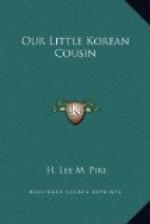It was far different with the boy’s mother. Her little boy soon learned that her wishes counted for very little in the family, and she never ventured to rebuke him, no matter how seriously he might offend her or what naughty thing he might do.
One queer thing about Yung Pak was the way he used to wear his hair. While still very young his head was shaved, except a little round spot on the very crown. Here it was allowed to grow, and as years went by it grew quite long, and was braided in two plaits down his back.
When Yung Pak grew to be a man the long hair was knotted up on top of his head, and for this reason many people call Koreans “Top-knots.” But of this arrangement of the hair we shall tell more farther on.
CHAPTER II.
YUNG PAK’S HOME
Ki Pak, Yung Pak’s father, was one of the king’s officials. On this account his home was near the great palace of the king, in the city of Seoul, the capital of the country.
This city did not look much like the ones in which you live. There were no wide streets, no high buildings, no street-cars. Instead, there were narrow, dirty lanes and open gutters. Shopkeepers not only occupied both sides of the crowded streets, but half their wares were exposed in and over the dirty gutters. Grain merchants and vegetable dealers jostled each other in the streets themselves. In and about among them played the boys of the city, not even half-clothed in most cases. There were no parks and playgrounds for them such as you have. Often, too, boys would be seen cantering through the streets, seated sidewise on the bare backs of ponies, caring nothing for passers-by, ponies, or each other—laughing, chatting, eating chestnuts. Other boys would be carrying on their heads small round tables covered with dishes of rice, pork, cabbage, wine, and other things.
[Illustration: A street in Seoul]
Around the city was a great wall of stone fourteen miles in length. In some places it clung to the edges of the mountains, and then dropped into a deep ravine, again to climb a still higher mountain, perhaps. In one direction it enclosed a forest, in another a barren plain. Great blocks were the stones, that had been in place many, many years. It must have taken hundreds and thousands of men to put them in position, and, though the wall was hundreds of years old, it was still well preserved. It was from twenty-five to forty feet high. The wall was hung from one end of the city to the other with ivy, which looked as if it had been growing in its place centuries before Yung Pak was born.
In the wall were eight gates, and at each one a keeper was stationed at all hours of the day and night. No persons could come in or go out unless their business was known to those who had charge of the passage.
Every evening, at sunset, the gates were closed, and during the night no one was allowed to pass through in either direction.




